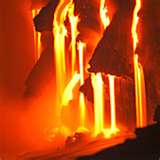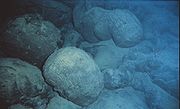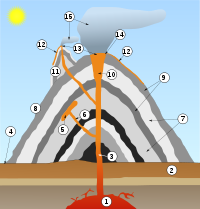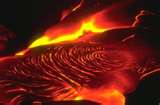What is a volcano?

A Volcano is a rupture in the earth's crust wich allows hot magma,ashes,and,gasses to escape from below the surface. Volcanoes are generally found where tectonic plates are diverging or converging. A mid-oceanic ridge for example the mid-atlantic has examples of volcanoscaused by tectonic plates pulling apart. The Pacific Ring of Fire has examples of volcanoes caused by tectonic plates coming together. Volcanoes are notusually created by tectonic plates sliding past each other. Volcanoes can also be formed by stretching and thinning of earth's crust.Volcanoes can also be caused by hotspots. Hotspots can be found on other planets and moons.
Lava Info

Another way of classifying volcanoes is by the composition of material erupted since this affects the shape of the volcano. Lava can be broadly classified into 4 different compositions.
If the eruptedmagma contains a high percentage of Silica the lava is called Felsic. Felsic lavas tend to be highly viscous and are erupted as domes or short, stubby flows. Viscous lavas tend to form stratovolcanoes or Lava Domes. Lassen Peak in California is an example of a volcano formed from felsic lava and is actually a large lava dome.
Because siliceous magmas are so viscous, they tend to trap gasses that are present, which cause the magma to erupt catastrophically, eventually forming stratovolcanoes. Pyroclastic Flows (igmbrites) are highly hazardous products of such volcanoes, since they are composed of molten volcanic ash too heavy to go up into the atmosphere, so they hug the volcano's slopes and travel far from their vents during large eruptions. Temperatures as high as 1,200 °C are known to occur in pyroclastic flows, which will incinerate everything flammable in their path and thick layers of hot pyroclastic flow deposits can be laid down, often up to many meters thick. Alaska's Valley of Ten Thousand Smokes, formed by the eruption of Novarupta near Katmai in 1912, is an example of a thick pyroclastic flow or ignimbrite deposit. Volcanic ash that is light enough to be erupted high into the Earth's atmosphere may travel many kilometres before it falls back to ground.
If the erupted magma contains 52–63% silica, the lava is of intermediate composition.
These "andesitic" volcanoes generally only occur above subduction zones.
Andesitic lava is typically formed at convergent boundary margins of tectonic plates, by several processes:
Hydration melting of peridotite and fractional crystallization
Melting of subducted slab containing sediments
Magma mixing between felsic rhyolitic and mafic basaltic magmas in an intermediate reservoir prior to emplacement or lava flow.
If the erupted magma contains <52% and >45% silica, the lava is called mafic because it contains higher percentages of magnesium and iron or basaltic. These lavas are usually much less viscous than rhyolitic lavas, depending on their eruption temperature; they also tend to be hotter than felsic lavas. Mafic lavas occur in a wide range of settings:
At mid-ocean ridges, where two oceanic plates are pulling apart, basaltic lava erupts as pillows to fill the gap;
Some erupted magmas contain <=45% silica and produce ultramafic lava. Ultramafic flows, also known as komatiites, are very rare; indeed, very few have been erupted at the Earth's surface since the Proterozoic, when the planet's heat flow was higher. They are (or were) the hottest lavas, and probably more fluid than common mafic lavas.
Lava texture Two types of lava are named according to the surface texture: ʻAʻa and pāhoehoe both words having Hawaiian origins. ʻAʻa is characterized by a rough, clinkery surface and is the typical texture of viscous lava flows. However, even basaltic or mafic flows can be erupted as ʻaʻa flows, particularly if the eruption rate is high and the slope is steep.
Pāhoehoe is characterized by its smooth and often ropey or wrinkly surface and is generally formed from more fluid lava flows. Usually, only mafic flows will erupt as pāhoehoe, since they often erupt at higher temperatures or have the proper chemical make-up to allow them to flow with greater fluidity
If the eruptedmagma contains a high percentage of Silica the lava is called Felsic. Felsic lavas tend to be highly viscous and are erupted as domes or short, stubby flows. Viscous lavas tend to form stratovolcanoes or Lava Domes. Lassen Peak in California is an example of a volcano formed from felsic lava and is actually a large lava dome.
Because siliceous magmas are so viscous, they tend to trap gasses that are present, which cause the magma to erupt catastrophically, eventually forming stratovolcanoes. Pyroclastic Flows (igmbrites) are highly hazardous products of such volcanoes, since they are composed of molten volcanic ash too heavy to go up into the atmosphere, so they hug the volcano's slopes and travel far from their vents during large eruptions. Temperatures as high as 1,200 °C are known to occur in pyroclastic flows, which will incinerate everything flammable in their path and thick layers of hot pyroclastic flow deposits can be laid down, often up to many meters thick. Alaska's Valley of Ten Thousand Smokes, formed by the eruption of Novarupta near Katmai in 1912, is an example of a thick pyroclastic flow or ignimbrite deposit. Volcanic ash that is light enough to be erupted high into the Earth's atmosphere may travel many kilometres before it falls back to ground.
If the erupted magma contains 52–63% silica, the lava is of intermediate composition.
These "andesitic" volcanoes generally only occur above subduction zones.
Andesitic lava is typically formed at convergent boundary margins of tectonic plates, by several processes:
Hydration melting of peridotite and fractional crystallization
Melting of subducted slab containing sediments
Magma mixing between felsic rhyolitic and mafic basaltic magmas in an intermediate reservoir prior to emplacement or lava flow.
If the erupted magma contains <52% and >45% silica, the lava is called mafic because it contains higher percentages of magnesium and iron or basaltic. These lavas are usually much less viscous than rhyolitic lavas, depending on their eruption temperature; they also tend to be hotter than felsic lavas. Mafic lavas occur in a wide range of settings:
At mid-ocean ridges, where two oceanic plates are pulling apart, basaltic lava erupts as pillows to fill the gap;
Some erupted magmas contain <=45% silica and produce ultramafic lava. Ultramafic flows, also known as komatiites, are very rare; indeed, very few have been erupted at the Earth's surface since the Proterozoic, when the planet's heat flow was higher. They are (or were) the hottest lavas, and probably more fluid than common mafic lavas.
Lava texture Two types of lava are named according to the surface texture: ʻAʻa and pāhoehoe both words having Hawaiian origins. ʻAʻa is characterized by a rough, clinkery surface and is the typical texture of viscous lava flows. However, even basaltic or mafic flows can be erupted as ʻaʻa flows, particularly if the eruption rate is high and the slope is steep.
Pāhoehoe is characterized by its smooth and often ropey or wrinkly surface and is generally formed from more fluid lava flows. Usually, only mafic flows will erupt as pāhoehoe, since they often erupt at higher temperatures or have the proper chemical make-up to allow them to flow with greater fluidity
Parts of a Volcano

1-Large Magma Chamber,2-Bedrock,3-Conduit,4-Base,5-Sill,6-Dike,7-Ash Layer,8-Flank,9-Lava Layers,10-Throat,11-Parasitic Cone,12-Lava Flow,13-Vent,14-Crater,15-Ash Cloud
Classifying Volcanoes

A popular way of classifying magmatic volcanoes is by their frequency of eruption, with those that erupt regularly called active, those that have erupted in historical times but are now quiet called dormant, and those that have not erupted in historical times called extinct. However, these popular classifications—extinct in particular—are practically meaningless to scientists. They use classifications which refer to a particular volcano's formative and eruptive processes and resulting shapes, which was explained above.
